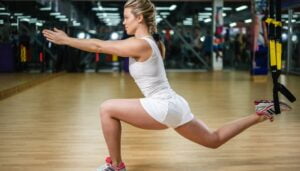How does the FITT principle apply to the development of a successful personal fitness program?
Question : How does the FITT principle apply to the development of a successful personal fitness program?
A. The FITT principle helps individuals determine an effective schedule for different exercise activities.
B. The FITT principle helps individuals choose the types of activities that will be most enjoyable for them.
C. The FITT principle makes it easier for individuals to incorporate lifestyle activities into their fitness programs.
D. The FITT principle allows individuals to monitor their progress.
Answer: B. The FITT principle helps individuals choose the types of activities that will be most enjoyable for them.
How Does the FITT Principle Apply to the Development of a Successful Personal Fitness Program?
Creating a personal fitness program can be challenging, especially if you’re not sure where to start. One effective method to develop a successful fitness plan is using the FITT principle. FITT stands for Frequency, Intensity, Time, and Type. This principle helps individuals create a balanced and enjoyable exercise routine. Let’s explore how the FITT principle can guide you in building a successful personal fitness program.
Frequency: How Often You Exercise
Frequency refers to how often you exercise. This can vary depending on your fitness goals and current fitness level. For beginners, it’s usually recommended to start with two to three days a week and gradually increase as your fitness improves. More advanced individuals might exercise four to six times a week.
Example:
- Beginners: 2-3 days a week
- Intermediate: 3-5 days a week
- Advanced: 4-6 days a week

Intensity: How Hard You Exercise
Intensity measures how hard you work during exercise. This can be adjusted based on your goals. For instance, if you’re looking to improve cardiovascular health, you might engage in moderate-intensity activities like brisk walking or cycling. If you’re aiming to build muscle, you might opt for high-intensity strength training exercises.
Example:
- Low Intensity: Light stretching, slow walking
- Moderate Intensity: Brisk walking, moderate cycling
- High Intensity: Running, high-intensity interval training (HIIT)

Time: How Long You Exercise
Time refers to the duration of your exercise sessions. The recommended duration can vary based on the intensity of the activity. For moderate-intensity exercises, aim for at least 30 minutes per session. For high-intensity workouts, 20 minutes might be sufficient.
Example:
- Moderate Intensity: 30-60 minutes per session
- High Intensity: 20-30 minutes per session

Type: What Kind of Exercise You Do
Type involves the kind of exercise you choose. This is where personal preference plays a significant role. Choosing activities you enjoy increases the likelihood of sticking with your program. Whether it’s running, swimming, yoga, or weightlifting, the key is to find what you love.
Example:
- Cardiovascular: Running, cycling, swimming
- Strength Training: Weightlifting, resistance band exercises
- Flexibility: Yoga, Pilates

Applying the FITT Principle
Now that you understand the components of the FITT principle, let’s see how you can apply it to create a personal fitness program.
1. Set Clear Goals
Start by defining what you want to achieve. Do you want to lose weight, build muscle, improve cardiovascular health, or increase flexibility? Having clear goals will help you determine the appropriate frequency, intensity, time, and type of exercise.
Examples of Goals:
- Lose 10 pounds in 3 months
- Run a 5K race in under 30 minutes
- Increase muscle mass and strength
- Improve flexibility and balance
Setting clear and achievable goals gives you direction and motivation. It also helps in tracking your progress over time.
2. Assess Your Current Fitness Level
Knowing your current fitness level helps you set realistic and achievable goals. This will also guide you in selecting the right intensity and duration for your workouts. You can assess your fitness level by measuring your cardiovascular endurance, muscular strength, flexibility, and body composition.
Ways to Assess Fitness Level:
- Cardiovascular Endurance: Measure how long you can run or walk at a steady pace.
- Muscular Strength: Test how many push-ups or sit-ups you can do in one minute.
- Flexibility: Check how far you can reach in a seated forward bend.
- Body Composition: Use a scale or body fat caliper to measure body fat percentage.
By understanding your starting point, you can tailor your fitness program to suit your needs and gradually improve over time.
3. Create a Balanced Routine
Incorporate a mix of different types of exercises to ensure a well-rounded fitness program. For example, you might do cardio on Monday, strength training on Wednesday, and yoga on Friday. This variety not only keeps your routine interesting but also ensures that all aspects of fitness are addressed.
Sample Weekly Routine:
- Monday: Cardio (Running)
- Tuesday: Rest or Light Activity (Walking)
- Wednesday: Strength Training (Weightlifting)
- Thursday: Flexibility (Yoga)
- Friday: Cardio (Cycling)
- Saturday: Strength Training (Bodyweight Exercises)
- Sunday: Rest or Light Activity (Stretching)
This balanced approach helps prevent overuse injuries and keeps you engaged with different activities.
4. Gradually Increase Frequency and Intensity
Start slowly and gradually increase the frequency and intensity of your workouts. This helps prevent injuries and ensures steady progress. It’s important to listen to your body and avoid pushing yourself too hard too quickly.
Progression Tips:
- Increase workout frequency by adding one extra day per week after a month.
- Increase intensity by adding more weight, speed, or resistance gradually.
- Extend workout time by adding 5-10 minutes to each session every few weeks.
By making gradual changes, you allow your body to adapt and improve without the risk of burnout or injury.
5. Monitor Your Progress
Keep track of your workouts and progress. This can be done through a fitness journal or apps. Monitoring progress helps you stay motivated and make necessary adjustments to your routine. It also allows you to celebrate milestones and achievements along the way.
Tracking Methods:
- Use a fitness app to log workouts and track progress.
- Maintain a workout journal to record exercises, sets, reps, and weights.
- Take regular measurements of body weight, body fat percentage, and circumference.
- Set short-term goals and review them weekly or monthly.
Regularly reviewing your progress helps you stay on track and make informed decisions about your fitness plan.
Example Fitness Program Using FITT
Goal: Improve overall fitness and lose weight
Frequency: 4 days a week
Intensity:
- Moderate for cardio
- High for strength training
Time:
- Cardio: 30 minutes
- Strength Training: 45 minutes
Type:
- Monday: Cardio (Running)
- Wednesday: Strength Training (Weightlifting)
- Friday: Cardio (Cycling)
- Sunday: Flexibility (Yoga)
This program ensures a mix of cardiovascular, strength, and flexibility exercises, helping you achieve a well-rounded fitness level.
Benefits of the FITT Principle
Using the FITT principle in your fitness program offers several benefits:
- Personalization: Tailor your workouts to your specific goals and preferences. This customization makes the fitness plan more effective and enjoyable.
- Variety: Incorporate different types of exercises to keep things interesting. This variety helps prevent boredom and maintains motivation.
- Progression: Gradually increase the challenge to avoid plateaus. Consistent progression ensures continuous improvement and avoids stagnation.
- Enjoyment: Choose activities you enjoy, making it easier to stick with your program. Enjoyable activities increase the likelihood of long-term adherence.
Common Mistakes to Avoid
While applying the FITT principle, be mindful of common mistakes that can hinder your progress:
- Overtraining: Avoid exercising too frequently or intensely without adequate rest. Overtraining can lead to injuries and burnout.
- Neglecting Warm-up and Cool-down: Always include a warm-up before and a cool-down after your workouts. These activities prepare your body for exercise and aid in recovery.
- Ignoring Nutrition: Complement your fitness program with a balanced diet. Proper nutrition fuels your workouts and supports recovery.
- Skipping Rest Days: Allow your body to rest and recover. Rest days are crucial for preventing injuries and promoting muscle growth.
- Setting Unrealistic Goals: Set achievable and realistic goals. Unrealistic goals can lead to frustration and disappointment.
Conclusion
The FITT principle is a valuable tool in developing a successful personal fitness program. By considering Frequency, Intensity, Time, and Type, you can create a balanced and enjoyable workout routine that meets your fitness goals. Remember to start slowly, listen to your body, and adjust your program as needed. With the FITT principle, you’ll be on your way to a healthier, fitter you.
For more information on fitness and exercise, check out these resources:
- American Heart Association: Exercise & Fitness
- Centers for Disease Control and Prevention: Physical Activity
- Mayo Clinic: Fitness
By applying the FITT principle and avoiding common mistakes, you can create a successful personal fitness program that keeps you motivated, engaged, and on the path to achieving your fitness goals. Remember, the key to a successful fitness program is consistency, progression, and enjoyment. Happy exercising!
